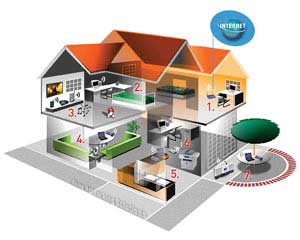The Wireless Home: Where All Devices Share One Online Connection, Transitioning from Hypothesis to Reality
 |
Image: Circuitcity |
Wireless technology today resembles the Internet back in 1998. At that time, computers were becoming common, but the web and email were just beginning to change how people communicated and shopped. With 98% of households still connecting via dial-up, the telecommunications industry boldly invested billions of dollars to roll out broadband technology.
Today, 55% of households in the U.S. have access to high-speed internet. The European broadband market is also experiencing robust growth, driven by decreasing subscription fees and the surge of new services, especially Internet Protocol Television (IPTV). In 2004, there were 15.4 million households in the region using broadband, which grew to 18.3 million last year, predominantly in Germany and the UK. Right now, the communications industry is preparing for another wave of innovation: mobile internet connectivity through 3G, Wi-Fi, and WiMax.
StrategyAnalytics evaluates that Wi-Fi technology is becoming the primary choice in households. Wireless internet is no longer limited to computers and laptops, but has expanded into mobile phones, gaming consoles, PDAs, and other entertainment systems. The production of Wi-Fi devices increased from 82 million in 2004 to 185 million in 2005.
The growth rate of Wi-Fi and broadband is not expected to weaken anytime soon, potentially reaching a saturation point very quickly. StrategyAnalytics estimates that by 2010, over 400 million Wi-Fi devices will be consumed, and 108 million households in Western Europe (equivalent to 63% of the region’s population) will be using high-speed internet.
However, some analysts argue that the goal of a wireless home may not be necessary at this time, as the prevailing trend in telecommunications is constant internet access, anywhere and anytime. Many service providers worldwide have begun establishing broadband access points, known as hotspots, in various locations. Last week, the British telecom company BT announced it would set up hotspots in 12 cities, including Leeds, Liverpool, and London. Meanwhile, public business venues such as cafes, airports, train stations, and hotels have long been quick to respond to the demand for wireless internet for customers. Google Maps even assists users in locating hotspots by area.
The British service provider Orange has pointed out several drawbacks of Wi-Fi as it gradually blurs the line between home and work. As wireless connectivity expands, it further narrows the real-life relationships between people. While individuals may rearrange their daily lives efficiently, such as by still dedicating time to care for their children or go to the movies, they may become less interested in or lose enthusiasm for socializing and casual interactions in everyday communication.
P.T.




















































